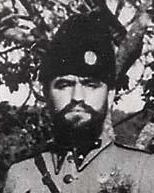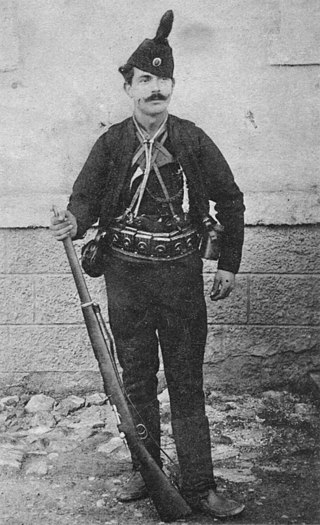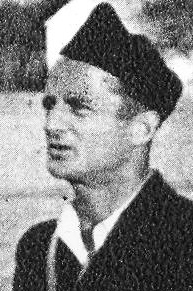
Case White, also known as the Fourth Enemy Offensive, was a combined Axis strategic offensive launched against the Yugoslav Partisans throughout occupied Yugoslavia during World War II. It was one of the most significant confrontations of World War II in Yugoslavia. The offensive took place in early 1943, between 20 January and mid-to-late March. The Axis operation prompted the Partisan Supreme Command to enact its plans to drive toward eastern Herzegovina, Sandžak and Montenegro.

The Yugoslav Partisans, or the National Liberation Army, officially the National Liberation Army and Partisan Detachments of Yugoslavia, was the communist-led anti-fascist resistance to the Axis powers in occupied Yugoslavia during World War II. Led by Josip Broz Tito, the Partisans are considered to be Europe's most effective anti-Axis resistance movement during World War II.

Momčilo Đujić was a Serbian Orthodox priest and Chetnik vojvoda. He led a significant proportion of the Chetniks within the northern Dalmatia and western Bosnia regions of the Independent State of Croatia (NDH), a fascist puppet state created from parts of the occupied Kingdom of Yugoslavia during World War II. In this role he collaborated extensively with the Italian and then the German occupying forces against the communist-led Partisan insurgency.
Operation Delphin was an anti-partisan operation in the Independent State of Croatia that took place in World War II, from 15 November to 1 December 1943. The objective of the mission was to destroy the Partisan elements on the Dalmatian islands off central Dalmatia.

Ilija Trifunović-Birčanin was a Serbian Chetnik military commander. He took part in the Balkan Wars and World War I and afterwards served as the president of the Association of Serb Chetniks for Freedom and the Fatherland in the Kingdom of Yugoslavia. In the spring of 1942, he was appointed by Mihailović as the commander of Chetniks in Dalmatia, Herzegovina, western Bosnia and southwestern Croatia. He died in Split on 3 February 1943, having suffered from poor health for a considerable period of time.
The 2nd Army was a World War I and World War II field army of the Royal Italian Army.

114th Jäger Division was a light infantry division of the German Army in World War II. It was formed in April 1943, following the reorganization and redesignation of the 714th Infantry Division. The 714th Division had been formed in May 1941, and transferred to Yugoslavia to conduct anti-partisan and Internal security operations. It was involved in Operation Delphin which was an anti-partisan operation in Croatia that took place between 15 November and 1 December 1943. The objective of the mission was to destroy the Partisan elements on the Dalmatian islands off central Dalmatia.

The 118th Jäger Division was a light infantry division of the German Army in World War II. It was formed in April 1943, by the redesignation of the 718th Infantry Division which had itself been formed in April 1941. It was transferred to Yugoslavia in May 1941, to conduct anti partisan and Internal security operations. It took part in the Battle of the Sutjeska in June 1943, and fought partisans in Bosnia before being sent to the Dalmatian coast to guard against Allied landings in the summer of 1944.

No. 351 Squadron RAF was a Yugoslav Partisan-manned fighter-bomber squadron of the Royal Air Force (RAF) which was operational between 13 October 1944 and 1 May 1945 during World War II. The squadron was also known by the Partisans as Second Squadron (NOVJ).

The Adriatic campaign of World War II was a minor naval campaign fought during World War II between the Greek, Yugoslavian and Italian navies, the Kriegsmarine, and the Mediterranean squadrons of the United Kingdom, France, and the Yugoslav Partisan naval forces. Considered a somewhat insignificant part of the naval warfare in World War II, it nonetheless saw interesting developments, given the specificity of the Dalmatian coastline.

Petar Baćović was a Bosnian Serb Chetnik commander within occupied Yugoslavia during World War II. From the summer of 1941 until April 1942, he headed the cabinet of the Ministry of Internal Affairs for Milan Nedić's puppet Government of National Salvation in the German-occupied territory of Serbia. In May and June 1942, Baćović participated in the joint Italian-Chetnik offensive against the Yugoslav Partisans in Montenegro. In July 1942, Baćović was appointed by the Chetnik leader Draža Mihailović and his Supreme Command as the commander of the Chetnik units in the regions of eastern Bosnia and Herzegovina within the Axis puppet state, the Independent State of Croatia. In this role, Baćović continued collaborating with the Italians against the Yugoslav Partisans, with his Chetniks formally recognised as Italian auxiliaries from mid-1942.

The Dinara Division was an irregular Chetnik formation that existed during the World War II Axis occupation of Yugoslavia that largely operated as auxiliaries of the occupying forces and fought the Yugoslav Partisans. Organized in 1942 with assistance from Ilija Trifunović-Birčanin and headed by Momčilo Đujić, the division incorporated commanders in Bosnia and Herzegovina, northern Dalmatia, and the Lika region. The division was under the control of supreme Chetnik commander Draža Mihailović and received aid from Dimitrije Ljotić, leader of the Serbian Volunteer Corps, and Milan Nedić, head of the Serbian puppet Government of National Salvation.

The 8th Dalmatian Shock Corps was a corps of the Yugoslav Partisans formed on 7 October 1943. It was formed from the 9th, 19th, 20th, and 26th Dalmatian divisions, and was named after the region of Dalmatia. Upon creation it had 13,049 soldiers. The corps operated in the Independent State of Croatia, Governorate of Dalmatia, and Adriatic Littoral, where they fought Italians, Chetniks, the Ustaše, and Germans.

The battle of Knin was a major Yugoslav Partisan operation during World War II in Yugoslavia launched by the 8th Dalmatian Corps from 7 November to 9 December 1944 with the purpose of destroying German, Ustaše and Chetnik formations in North Dalmatia and the city of Knin, then part of the Independent State of Croatia. It was the final part of the 8th Corps offensive for the liberation of Dalmatia which began on 12 September 1944. The Knin operation had three phases: Initial battles on approaches to Knin from 7 November to 25 November, main battle and liberation of Knin from 26 November to 4 December, and final battles and pursuit of retreating Axis forces to Otrić in Lika from 5 December to 9 December.

Vicko Krstulović was a Yugoslav communist revolutionary, the most prominent Partisan military commander from Dalmatia during World War II, and a post-war communist politician. He was an illegal communist activist during the 1920s and 1930s in Split at a time when communist sympathizers were brutally persecuted by the Yugoslav monarchy. As an officer in the Partisans during World War II, he was in charge of creating and organising the resistance movement in Dalmatia. In Socialist Yugoslavia, he worked in various government offices and was remembered for his work and contribution to his native Split.
The 4th Army of the Yugoslav Partisans was a Partisan army that operated in Yugoslavia during the last months of the Second World War.

The 2nd Proletarian Division was a Yugoslav Partisan division formed in Tičevo on 1 November 1942. It was formed from 2nd Proletarian Brigade, 4th Proletarian Brigade and 2nd Dalmatia Brigade, at the time of formation it consisted of around 2,680 soldiers. The unit took part in almost all important Partisan operations. On 1 September 1943, it became part of the 2nd Assault Corps.

The 19th North Dalmatia Division was a Yugoslav Partisan division formed in Biovičino Selo on 4 October 1943. Upon formation it had 3,559 soldiers in three brigades, those being: the 5th, 6th and 7th Dalmatia Brigades. During all of its existence it was a part of the 8th Corps. Commander of the division was Milan Kuprešanin while its political commissar was Petar Babić. The division mostly operated in Dalmatia, Lika and Bosnia.

The 26th Dalmatia Division was a Yugoslav Partisan division formed on 8 October 1943. It was formed from the 11th, 12th and 13th Dalmatia Brigades. In January 1944, the 13th Dalmatia Brigade left the division while the 1st Dalmatia Brigade joined it. The 3rd Overseas Brigade joined the division in March 1944. The division mostly operated in the Southern Dalmatia where it fought against parts of the 2nd Panzer Army, 118th Jäger Division, 7th SS Division, and 369th Infantry Division.

The 29th (Herzegovinian) Division was a Yugoslav Partisan division formed on 16 November 1943. It was formed from the 10th, 2nd and 3rd Herzegovinian Brigades which had a total strength of 1,567 fighters. Since its formation, the 29th Division was a part of the 2nd Corps.













